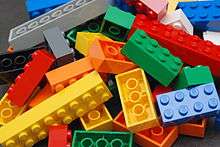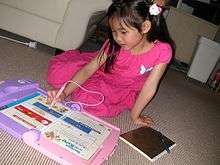Educational toy


Toys may be used for a number of educational purposes. Some toys have incidental educational value, while others are known specifically by the moniker of "educational toys." Educational toys are typically built for and used by young children. One could make the argument that an educational toy is actually any toy. Most children are constantly interacting with and learning about the world. This definition is ultimately too broad because one could make the same argument about a rock or a stick as it is not uncommon to see a child play with almost anything nearby.
The difference lies in the child's perception or reality of the toy's value. An educational toy should educate. It should instruct, promote intellectuality, emotional or physical development. An educational toy can teach a child about a particular subject or can help a child develop a particular skill. The key difference is the child's learning and development associated with interacting with the toy.
More toys are designed with the child's education and development in mind today than ever before. As parents and educators grow more sensitive to the real or perceived development needs of children, toy manufacturers seek to manufacture and market to these parents.
Wooden toys which tend to last for a long time serve to maintain interest and durability for the child especially if the toy becomes a favorite.
Advertising
The term educational toy is often applied in toy advertising to promote sales to parents. Such toys are often more expensive than traditional ones. Indeed, the Early Learning Centre shop is founded on the premise of educational toys, and is more expensive than average. The packaging of many toys includes a table of skills and benefits imbued by the product. However, the actual developmental benefit of these, by comparison to a cheaper, simpler or more easily available product, is often unproven.
In child development
Educational toys claim to enhance intellectual, social, emotional, and/or physical development. Educational toys are thus designed to encourage reasonable development milestones within appropriate age groups. For preschool age youngsters, simple wooden blocks might be a good starting point for a child to begin to understand causal relationships, basic principles of science (e.g. if a block falls from the top of a structure, it will fall until a surface stops its fall), and develop patience and rudimentary hand-eye coordination. For a child moving towards elementary school, other, more sophisticated manipulatives might further aid the development of these skills. Interlocking manipulative toys like Lego or puzzles challenge the child to improve hand-eye coordination, patience, and an understanding of spatial relationships. Finally, a child in elementary school might use very sophisticated construction sets that include moving parts, motors and others to help further understand the complex workings of the world. Importantly, the educational value derived by the child increases when the educational toy is age appropriate.
Child computer

Some manufacturers regarded normal personal computers as an inappropriate platform for learning software for younger children and produced custom child-friendly pieces of hardware instead. The hardware and software is generally combined into a single product, such as a laptop-lookalike. Such computers may be custom-designed standalone toys, or personal computers tailored for children's use.
Some common examples include imaginatively designed handheld game consoles with a variety of pluggable educational game cartridges and book-like electronic devices into which a variety of electronic books can be loaded. These products are more portable than general laptop computers, but have a much more limited range of purposes, concentrating on literacy and numeracy.
Ergonomic hardware is fundamental for baby learning, where Tablet PCs and touchscreens are preferably used instead of keyboards and computer mice. Also, a sandbox environment is created, to disable the use of the keyboard (excepting some combination of keys that can only be typed by an adult), taskbar and opening of other programs and screens. Child computer keyboards may use large and differently colored keys to help differentiate them. Baby and toddler computers include ABC keyboards. Some child computers include QWERTY keyboards as an early aid in learning typing. Small mice, about half the size of a typical adult mouse, are used in toddler's computers. They are programmed for “one-click” operation. The case may be reinforced to protect it from misadventure. Such computers are not seen as a replacement for time spent parenting.[5]
Examples

Examples of educational toys include:
- Building toys, such as toy blocks.
- Automoblox wooden construction cars
- Scale models
- Engino
- Construction toys
- Electronic toys
- Speak & Spell, Speak & Read, and Speak & Math
- VideoSmarts and ComputerSmarts
- Many VTech and LeapFrog products
- Models of real objects
- Model aircraft
- Model railroads
- Model cars and other vehicles
- Model animals, e.g. Carnegie collection
- Model microbes, e.g. GIANTmicrobes
- Playmobil model scenes
- Musical instruments
- Robot and Robot kits
- Science kits
- Physics
See also
| Wikimedia Commons has media related to Educational toys. |
- Constructionism (learning theory)
- Education
- Educational game
- Educational software
- Parenting styles
- Puzzle
- Toy advertising